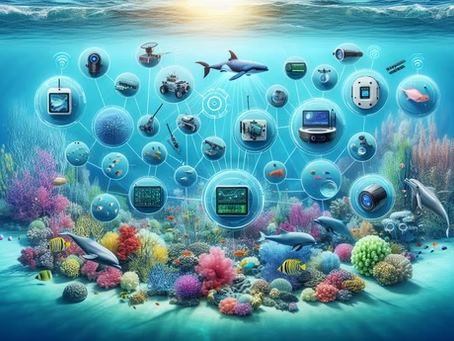Introduction
Marine conservation stands at a pivotal moment as cutting-edge technologies reshape how we monitor, protect, and understand the ocean. From underwater satellites and AI-powered drones to DNA sequencing and wireless communication networks, these tools are transforming conservation from reactive measures into proactive strategies. This article explores the most promising innovations and their role in safeguarding marine biodiversity for future generations.
Diving into the Deep: Underwater Surveillance Tech
The Rise of Underwater Satellites
Underwater satellites—AI-driven robots exploring the ocean floor—are revolutionizing marine science. They deliver detailed maps of ecosystems, track biodiversity, and provide real-time data on climate change impacts. By connecting the unseen deep sea with land-based researchers, these technologies open new doors for conservation and policy-making.
AI and Machine Learning
AI is no longer a futuristic idea; it is central to ocean research. Machine learning models forecast ecosystem changes, detect elusive marine species, and optimize conservation interventions. By analyzing massive datasets, AI acts as both a partner and a decision-making tool, ensuring conservation actions are targeted and effective.
The Internet of Underwater Things
Real-Time Data Collection
Wireless networks beneath the waves are linking tagged marine life, shipwreck sensors, and cameras into connected ecosystems. This Internet of Underwater Things creates digital twins of ocean conditions, enabling simulations that help policymakers test conservation strategies before applying them in reality.
Building Underwater Wireless Networks
Acoustic devices and robotic solutions now transmit data from the seafloor to buoys and into cloud systems. Projects like the EU-funded TEUTA are making these systems more affordable and accessible, laying the foundation for global real-time ocean monitoring.
Protecting Marine Mammals
Acoustic Buoys
High-tech buoys detect whale songs and alert nearby ships, dramatically reducing the risk of collisions. Initiatives such as Whale Safe combine these buoys with AI systems to protect whales across shipping routes while providing researchers with population data.
AI-Powered Drones and Infrared Imaging
Drones equipped with AI and infrared sensors monitor whales across vast ocean regions, even in challenging Arctic conditions. These aerial guardians not only help prevent ship strikes but also generate valuable insights into whale migration and population health.
The Ocean Census: Discovering New Species
Remote robots, hyperspectral imaging, and DNA sequencing are fueling the ambitious Ocean Census project to identify 100,000 new species. By analyzing environmental DNA and mapping the seafloor in detail, conservationists gain powerful tools to understand biodiversity and develop targeted protection strategies.
Guardians of the Blue: AI in Conservation
Monitoring Protected Areas
AI-powered systems now monitor marine protected areas around the clock, identifying species, spotting poaching activity, and informing ecosystem restoration projects. These algorithms act as digital rangers, ensuring conservation goals are met with efficiency and precision.
Tracking Migratory Species
Machine learning turns camera traps and sensors into real-time migration trackers, predicting movement patterns and supporting anti-poaching efforts. This leap in monitoring strengthens protection for endangered marine travelers.
Synergy of Tech and Nature
Restoration Technologies
Innovations in kelp and seagrass restoration, combined with regenerative aquaculture, enhance carbon capture and rebuild critical habitats. With strong collaboration, scientists estimate ocean ecosystems could recover within three decades.
Assessing Climate Interactions
Advanced models now assess the ocean’s role in climate regulation, particularly its carbon sinks. Protecting these reserves is essential in tackling climate change while fostering sustainable blue economies worldwide.
Innovation Showcase
Long-Range Autonomous Systems
Uncrewed vessels equipped with sensors and weather stations travel across oceans, creating a distributed network of real-time data collection. These autonomous systems transform fishing boats and research ships into floating conservation laboratories.
The Role of Robotics
Robotics is driving marine discovery, from Planblue’s underwater “satellites” to Ocean Census’s species detection. Integrated with wireless networks, these machines expand our ability to study and protect marine life.
The Blue Marine Foundation’s Tech-Forward Approach
The Blue Marine Foundation integrates underwater cameras, drones, AI systems, and monitoring buoys to track biodiversity, monitor protected areas, and engage the public with visual insights into marine ecosystems. Their work illustrates how technology and advocacy combine to advance conservation globally.
Conclusion
From deep-sea exploration to whale protection, innovations in marine conservation are reshaping our relationship with the ocean. AI, robotics, and digital networks are not just tools but lifelines ensuring the resilience of marine ecosystems. With projects like Ocean Census and initiatives by groups such as the Blue Marine Foundation, technology is charting a hopeful course toward a thriving, sustainable ocean future.

